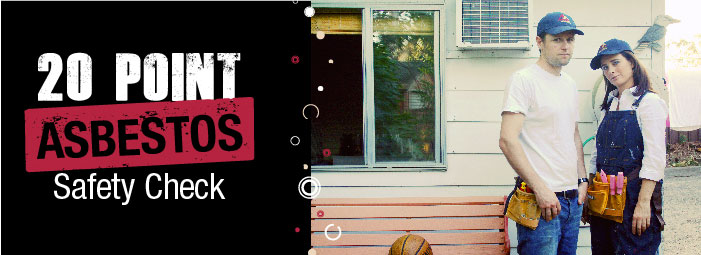The Government's EPA have decided that all fibro is asbestos unless proven otherwise. This means that you cannot put fibro in a regular bin, or we will both be fined. Please see the guide below for what you should do to dispose of fibro now. Thank you, Matt.
GUIDE TO TELL IF IT IS FIBRO OR ASBESTOS
The EPA now require that all fibro is treated as though it has asbestos in it, unless you can prove otherwise. To prove otherwise you need to do one of 2 things:
- Pay $40 to the EPA and they will test the fibro and issue a clearance certificate;
- Check the back of the sheet. Look for a green stamp that says "asbestos free".
Otherwise you will need to treat the fibro as though it contains asbestos. This means wrapping each sheet or piece in 2 layers of plastic and sealing it, then order an asbestos bin from us for removal. You cannot put double wrapped fibro/asbestos into a general bin, the plastic may puncture and the bin will have to be charged as though it was all asbestos. There is also a Government fine for that. Please note this is not our rules and all legal Skp Bin companies must comply. if you get someone who does accept fibro unwrapped it is probably best to report them to the Council as they are dumping their bins in the bush to avoid high dumping fees and fines.
They used to make "Fibrolite" asbestos sheeting.Villaboard was originally a Wunderlich asbestos product and in 1981 Hardies started production of the cellulose version of Villaboard. Wunderlich had a dimpled backed. If it is 6mm thick and breaks softly, it is cellulose not asbestos. Here is a photo of Asbestos Fibrolite, note the dimpled back:
About Asbestos
Renovators - if you are removing fibro or floor tiles from a house built before 1987 you probably have Asbestos in your bin, please read this section carefully. We are licensed to remove Asbestos however there is a significant extra cost. Illegally disposing of Asbestos by hiding it in a general bin is against the law.
If you are thinking about renovating, you must be aware of asbestos. It is important for home owners and renovators to be aware of how to safely manage asbestos in and around the home. It becomes a health risk when asbestos fibres are released into the air and breathed in.
What is Asbestos?
Until the mid-1980s, asbestos was widely used in a range of home building materials. If your house was built or renovated before 1987, it is likely you have asbestos in your home.
Asbestos fibres were used widely in building materials before the mid-1980s. If your house was built or renovated before the mid-1980s, it is likely to contain asbestos cement building materials.
You may be surprised at the various types of products that were made from bonded asbestos cement included fibro sheeting (flat and corrugated), water drainage and flue pipes, roofing shingles and guttering, even the backing of vinyl floor tiles.
In NSW, the use of asbestos was discontinued in all fibro sheets and products by the mid-1980s. After this, asbestos was used for brake and clutch linings until being banned from 31 December 2003.
Removing asbestos is a dangerous and complicated process best carried out by professionals who are licenced having completed the required training. If you were to consider removing a small amount of asbestos yourself, at the very minimum you would need to meticulously follow ALL of the steps described on the Asbestos Awareness Website. Skip Bins Central Coast are licensed to dispose of Asbestos once correctly prepared at the building site.
Types of Asbestos
Asbestos is described as either "bonded" or "friable".
Bonded asbestos fibres are mixed into another material which binds or bonds them within the material. Bonded asbestos cannot be crumbled, pulverised or reduced to a powder by hand pressure when dry. Common uses for bonded asbestos in buildings include: flat (fibro), corrugated (roofing) or compressed asbestos cement sheets; water, drainage and flue pipes; and floor tiles.
If fire, hail, or direct activities such as water blasting and drilling damages bonded asbestos, it may become friable asbestos material. Friable asbestos material is any material that contains asbestos and is in the form of a powder or can be crumbled, pulverised or reduced to powder by hand pressure when dry.
Friable asbestos was not commonly used in the home; it was mainly used in industrial applications such as pipe lagging, sprayed limpet and asbestos cloth and rope. Friable asbestos can only be removed by a licenced asbestos removalist with a friable asbestos licence.
Where asbestos fibres are friable (loose and not bonded into building materials), only licenced friable asbestos removalists are allowed to remove it
If you do need to work with any material that may contain asbestos, ensure you take all the necessary precautions to protect yourself and minimise the release of dust or small particles from the asbestos materials that may affect others including children

